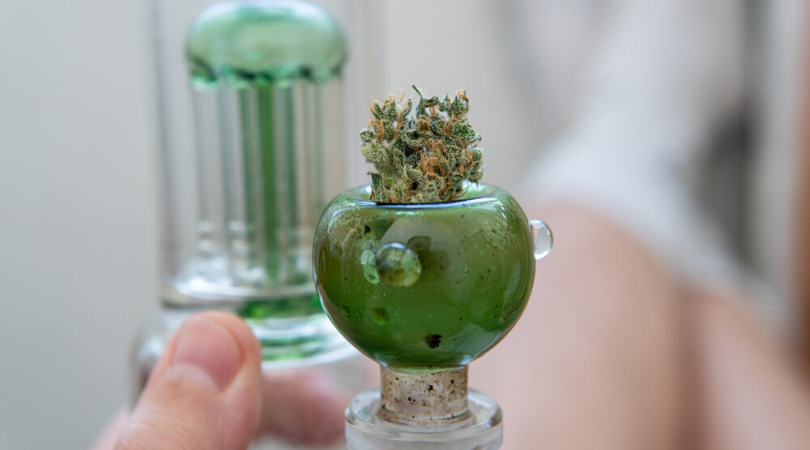
Once you’ve got a good grasp of how to inhale from a bong, perhaps it’s time to explore extra options to get even more from that glass piece of yours — what do you think?
Does an “ash catcher” ring a bell?
No?
That’s ok, nobody’s born an expert.
Ash catchers are pure gold for people who want to keep their bongs pristine clean and enjoy smooth hits every time they pull the smoke from the chamber through the many percolators.
At the end of the day, an ash catcher may become a must-have item in your bong toolkit.
But what are ash catchers in the first place? We’ve already introduced them in a very flattering light, so it would be impolite to simply leave you without an explanation.
Today, we’ll show you why an ash catcher is important for your bong sessions and how to choose a suitable glass ash catcher for your favorite water pipe.
Let us begin.
What Is an Ash Catcher?
Ash catcher is a small glass chamber that gets attached to the joint of your bong, somewhere between the bowl slide and the bong itself.
The device is filled with water, and some models even include additional percolators. Its main purpose, however, is to catch loose ash before it makes it to the bottom of your bong.
The core idea behind ash catchers is simple. These attachments create an extra barrier and another layer of diffusion to your bong,
For example, when you take a hit from a 12” straight tube bong without a glass ash catcher, you’ll likely end up inhaling herb ash from your piece. But if you use one, your hits will suddenly become smooth and ash-free.
Ash catchers come in different shapes, sizes, and designs. As mentioned, they can feature different percolators to filter the smoke even more effectively before it makes it to the main percolator of your unit.
Because of that, you should always buy an ash catcher that’s appropriate for your bong model.
Why Do You Need an Ash Catcher for Your Bong?
If you’re a regular toker, a glass ash catcher offers plenty of perks.
Here’s why you need one:
- It keeps your bong clean for longer
- It makes maintenance easier
- Every hit is clean and fresh — you never “eat” the ash
- Ash catchers are easier to rinse and soak than a full-sized bong
- Additional percolators lead to smoother rips
- You can rejuvenate old sidekicks without having to buy a new bong
- High-quality ash catchers are made from borosilicate glass. It’s thick, so it can last a while.
- Ash catchers simply look amazing.

How to Choose a Suitable Glass Ash Catcher
We understand that you must be excited to get up from your chair and head to the nearest head shop to buy an ash catcher, but hold your horses for a second, please.
Before you choose a glass ash catcher for your bong, ask yourself the following questions:
- What’s the joint size of your bong?
- At which angle does the joint stick out from the bong?
- Is the joint male or female?
- Are you looking for honeycomb or showerhead percolators?
If your ash catcher comes with a covetable interior coil, it’s all the better — it will deliver chilly and smooth inhales, making your toking session beyond exhilarating.
Below we explain how to choose a suitable glass ash catcher for your bong.
1. Decide on the Style of the Stem
As mentioned, glass catchers are available in different styles, especially when it comes to the stem. The stem is an important area for percolation and diffusion, so you must make a well thought out decision.
The stem you buy should match the style of diffusion you opt for. Top-shelf glass companies offer high-quality ash catchers to fit various styles of diffusion and percolation, so you’ll definitely have some options.
2. Check the Weight of Your Glass Ash Catcher
This is the second-most important feature on our list because it determines the center of gravity and prevents the pipe from falling over once you attach the ash catcher.
If your piece is too heavy, you may end up breaking your pipe into pieces. Some people like to use more than one ash catcher for improved filtration, so if you’re one of them, just remember that the tip over scenario is much more likely to happen. If you want to stack your ash catchers, make sure you provide your bong with enough balance to withstand the extra weight.
3. Measure the Angle of the Joint
You can attach ash catchers to different styles of bongs, which is why you need to choose the one that’s designed to fit the angle of the joint. There are 45-degree angle ash catchers and 90-degree ash catchers.

4. Choose the Right Joint Size
Choosing the right joint size for your ash catcher depends on the size of the joint on the pipe you’ll be working with. If your water pipe comes with a 18mm slide, you’ll have to pick an ash catcher of the matching size.
Don’t panic if there’s a glass ash catcher you’ve fallen in love from the first sight but it doesn’t fit your bong. Today, glass companies have created adapters that can be used to combine pieces that have different joint sizes.
5. The Joint’s Gender Matters
As much as we’re against the war between the sexes, making this choice is inevitable if you want to find a suitable glass ash catcher. Joint gender is a crucial trate that buyers must consider when browsing through different products.
If your bong uses a male joint, you’ll need to pair it with a female ash catcher — and the other way round. Again, you can always use an adapter to get the two “unfitting” pieces working together.
Final Thoughts on Choosing a Suitable Glass Ash Catcher for Your Bong
Ash catchers are the perfect solution for regular bong users who want to draw the most out of their smoking sessions and always keep their glass pieces fresh and clean. Plus, they add extra percolation to your water pipe, and you don’t need to break the bank to buy one.
Functionality and affordability at the same time? Count us in!
Do you use ash catchers for your bongs?





